‘My journey into compassion fatigue’
Editor’s note: In this story, Katie Scaff ’13 writes about her experiences creating the documentary Overexposed – an examination of compassion fatigue, with two other students and her communications professor. The faculty-student research project exposes students to the realities of world issues and makes them masterful storytellers.
A detour to Joplin
We stepped out of the car and were immediately hit with a hazy fog. We could almost see the heat rising from the blistering pavement, and all around, clothes, furniture, blankets, refrigerators, and pieces of wood and brick, recklessly rearranged into an unrecognizable mess.
Trees stood bare as far as the eye could see. Their branches had been ripped off in the violent winds and lie wherever they landed. Walls were stripped from houses and some were torn from their very foundation leaving nothing but a cement block.
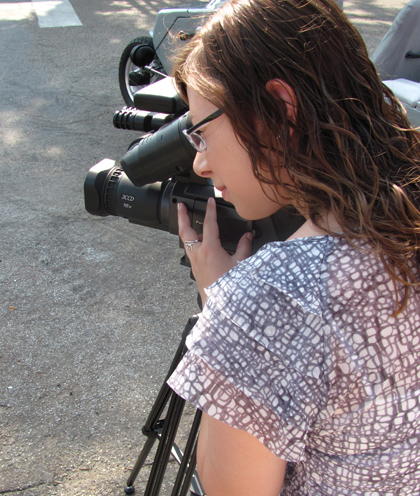
Katie Scaff ’13 films Elmwood, Mo. residents at the town’s annual Strawberry Festival on Saturday, June 4, 2011.
Two weeks earlier the deadliest tornado in our nation’s history ripped through Joplin, Mo., killing 160 people and causing almost $3 billion in damage.
Today our goal was to interview any survivors and relief workers we could find. We figured the best place to find people would be in the center of the devastation.
I was traveling the country researching for a documentary on compassion fatigue, an issue that particularly affects caregivers and first responders, with three other students and one of my communications professors.
If you had told me that I would be spending my summer vacation interviewing tornado victims or 9/11 first responders, I would have thought you were crazy.
When I came to PLU in September 2009 I had no idea what opportunities and experiences awaited me. I was young, naïve and had no idea what I wanted to do with my life. I took Writing 101 with Associate Professor of Communication Robert Wells during my first semester and that led me to a student-faculty research organization called MediaLab, for which Professor Wells, or Rob, as we call him, is the advisor.
Our stop in Joplin was unplanned, but we were in the area and knew a research opportunity when we saw one. Rather than driving straight to our next interview in Scranton, Pa., we opted to make a pit stop in Joplin. We knew it wouldn’t be easy to go there to get interviews, but this was something we needed to do.
The journalist in me was so eager to talk to survivors when we got in the car before the four-hour drive to Joplin, but that all changed once we got there.
At first, it didn’t even look like a tornado had hit. We stopped off the road to ask someone where the affected area was and they said, “Keep driving, you can’t miss it.”
We continued down the main road, took a left after, and there it was. The first thing we saw was the high school. The roof had collapsed on half of the building, looking like it had been hit by a series of bombs, like it could collapse at any moment.
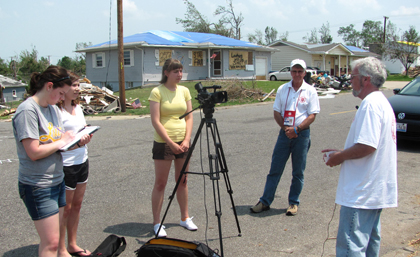
MediaLab’s Overexposed team (Hailey Rile ’12, Katie Scaff ’13, and Elizabeth Herzfeldt-Kamprath ’12) interviews retired disaster coordinator Ron Harmon in Joplin on Sunday, June 5, two weeks after the tornado hit.
To my surprise and dismay, the chain-link fence surrounding the school stood perfectly in place.
After we passed the school, we entered a residential area, where the tornado had done most of its destruction.
None of us wanted to get out of the car to talk to people. We were frozen, without words. When I finally emerged from our minivan, it felt as if I had stepped onto the set of a Hollywood doomsday film. Everything looked a little hazy and I couldn’t believe my eyes. How could this be real?
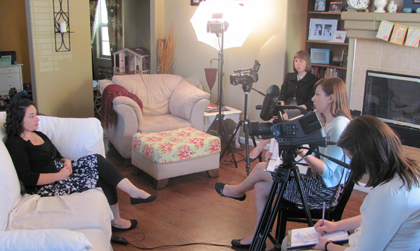
MediaLab’s Overexposed documentary team interviews stay-at-home blogger mom Jeannett Gibson at her home in Santa Maria, California on Tuesday, May 31.
I didn’t know what to feel or how to react. I kept telling myself this is real, but I couldn’t fathom it and I kept coming back to the idea that it was just the set of a film.
Amidst the devastation, though, I found a glimmer of hope. People – people cleaning up their lawns and people driving around offering fresh food and water.
I was captivated and inspired by their hope, and talking with these people helped me understand the tragedy so much more. Among our interviewees was a pastor who had opened up his church as a distribution warehouse.
Our time in Joplin was brief, limited to a long afternoon, but the things we saw and the people we met had an influence on each of us.
Comprehending 9/11
More than 1,200 miles away we learned, first-hand, the toll a devastating event can have on first-responders, as we began to grasp the cost rescuers of 9/11 are still paying.
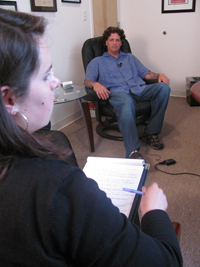
Hailey Rile ’12 interviews retired New York City firefighter Bobby Senn, who was a first responder in the 9/11 attacks on the Twin Towers.
How we understood 9/11 changed after interviewing retired New York City Firefighter Bobby Senn – a man that was responding to the call that day.
We spent more than two hours interviewing Senn and his psychologist Mark Lerner, Ph.D.
“You guys will never understand the level of horror that was going on in lower Manhattan that day,” Senn told us. “Going into work I had a spring in my step, couldn’t wait to get there.”
Everything changed at 8:45 a.m. As soon as he arrived on scene, he witnessed the tail end of the second plane just before it hit the south tower. Looking up at the towers, he said he could see people in the windows one hundred floors up. They started jumping.
“It was an excess of 100 degrees up there,” Senn said. “They knew this was it. There was nothing we could do about it. Their destiny had been created for them.”
He was twice thrown from the impact of the towers collapsing and buried alive in the rubble. He was later taken to a hospital where he was treated for second degree burns in his eyes and a broken hand. Senn had us on the verge of tears as he recalled the events.
Despite all his physical injuries, Senn worked into the evening before he was taken to a hospital later that night.
“Everything was a mess,” Senn said. “I was running strictly on adrenaline.”
For me, Senn gave meaning to a disaster whose influence I never fully understood. I was in the fifth grade when 9/11 happened. I remember seeing the planes crashing on the news, but I couldn’t comprehend how horrendous the tragedy was until I heard it in Bobby’s words. His words were real, unlike anything I heard on the news.
Our own fatigue
While I learned a lot about compassion fatigue from our interviews and field experiences, I also learned a lot about my teammates, and myself because of how much time we spent together.
Like any trip, we were all eager and excited when we met at SeaTac the morning of May 30. We couldn’t wait to explore our topic and meet and interview the people we had spent months researching.
About a week in though, a fatigue hit us. We were sick of living out of a suitcase, sick of the long car rides, sick of eating out meal after meal after meal, and somewhat sick of being around each other 24/7.
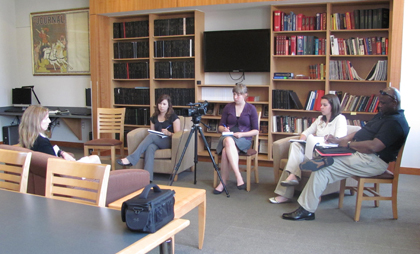
MediaLab’s Overexposed team interviews Susan Moeller at the University of Maryland, where she teaches Media and International Affairs in the Philip Merrill College of Journalism.
I wouldn’t call it compassion fatigue, but more of a burnout, a distinction I feel confident making after all my research.
But just like the caregivers we studied, we knew that our work wasn’t about us as individuals, but instead about doing something greater than ourselves. It was experiences, like that in Joplin and interviewing Bobby Senn, which helped remind us of our mission.
My teammate, Elizabeth Herzfeldt-Kamprath ’12, was also changed by our research and experiences.
“Through talking with experts and people who have experienced compassion fatigue, I learned that there is strength in recognizing when you need to take a break,” Herzfeldt-Kamprath said. “To work through your weakest time may prove to be harmful rather than helpful.”


